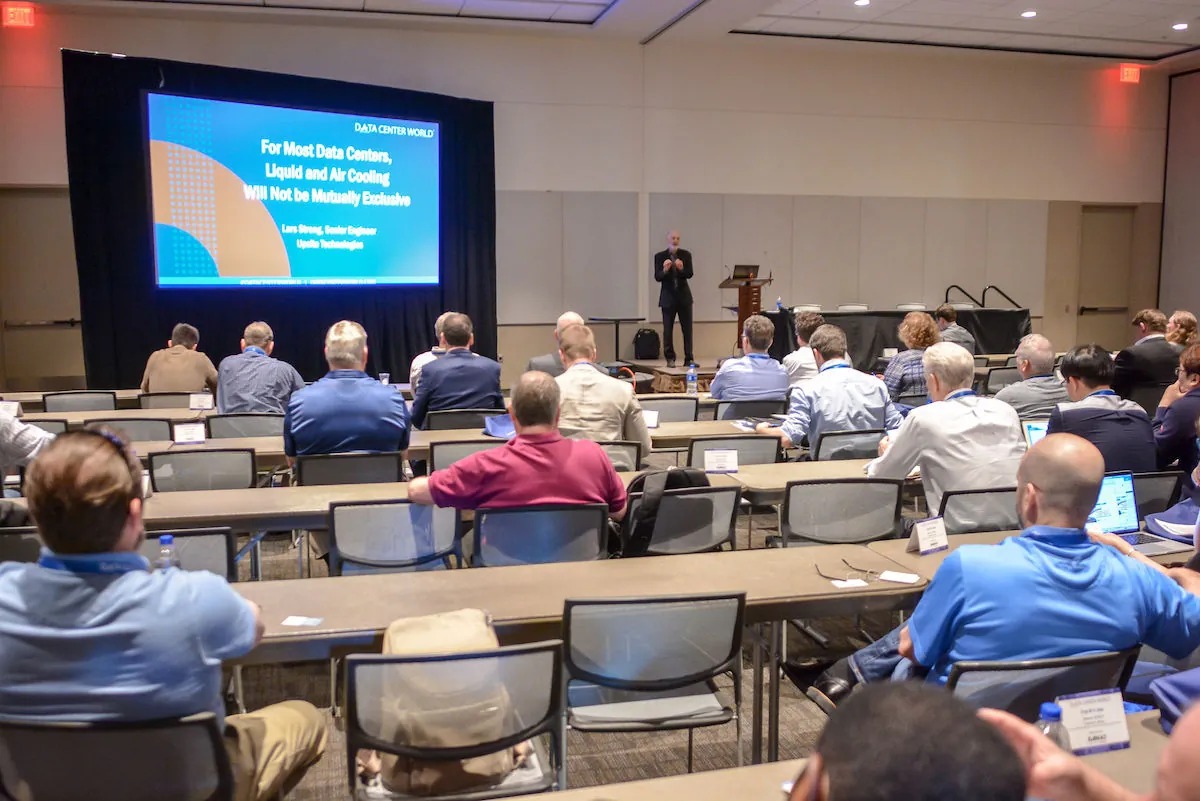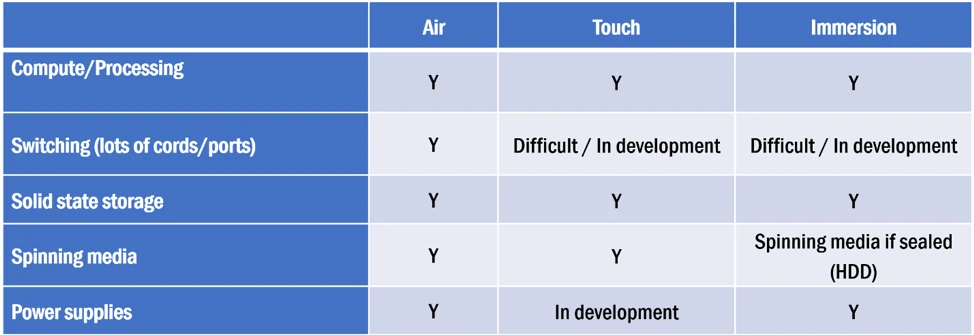AFCOM Data Center World: A Look at Liquid Cooling15 min read

Image by Steve Hall Photography
When I wasn’t speaking or doing networking events at Data Center World, I had the pleasure of attending a few fun sessions. On my radar was a session being led by one of Upsite’s leading engineers, Lars Strong.
During that session, Lars discussed some really interesting concepts around liquid cooling and just how long it’s been around. Let’s start here; according to Lars, early concepts of liquid cooling have actually been around since 1887. Since then, the technology has certainly come a long way.
Adoption of Liquid Cooling
Between 1970 and 1995, a lot of liquid cooling was done within mainframe systems. Then, in the 90s, we began to see more gaming and custom-built PCs adopt liquid cooling for high-end performance requirements. Between 2005 and 2010, liquid cooling found its way into the data center with chilled doors. From there, looking into 2010 and beyond, liquid cooling was used in high performance computing (HPC) environments as well as designs featuring direct contact and full immersion liquid cooling solutions.
If you look at the market today, you’ll see a lot more buzz around liquid cooling adoption. Water-based cooling, a sub-segment of liquid-based cooling, is the most widely accepted cooling system. According to Technavio, the global data center cooling market using liquid-based cooling techniques is expected to grow at a remarkable rate through 2020, posting a CAGR of almost 16% during the forecast period.
Furthermore, according to Stratistics MRC, the Global Data Center Liquid Cooling market was estimated at $0.64 billion in 2015 and is expected to reach $3.56 billion by 2022 growing at a CAGR of 27.7% from 2015 to 2022. Rising need for eco-friendly solutions and increasing power density of server rack are the key drivers fueling the market growth.
Key Drivers for Liquid Cooling
- Density – Think HPC computing where you’re running latency-sensitive applications and workloads. Liquid cooling helps you keep systems dense while maintaining high levels of performance.
- Performance – Use-cases around research, modeling, finance tracking all require high levels of performance. And, it’s a great area for liquid cooling to make an impact.
- Economy – It’s not just about economy; it’s also about efficiency. IT fans represent around 20% of all IT loads. Furthermore, a liquid cooling solution can impact all aspects of power distribution including switch gears, UPS, PDUs, and so on. Finally, warm water-cooling systems can actually produce significant CapEx and OpEx savings.
- More Accurate PUE – Server fans are on the IT load side of the PUE equation. However, according to Lars, they really are a part of the cooling infrastructure. So, a liquid cooling solution can actually help you deliver a more accurate PUE reading.
Resistance to Liquid Cooling
With all of this in mind – there are reasons that some aren’t just outright deploying a liquid cooling solution. During his session, Lars pointed out some barriers to adoption.
- Air is simply understood and is more familiar
- It’s an entire paradigm shift when you look at from a care and immersion perspective
- There is the perception of risk where you have liquid in the cabinet that may cause an outage
- It’s not quite as standardized as many fan or air cooling options
- Initial capital costs
- Additional complexity of running two systems: air and liquid cooling
What Does Air and Liquid Cool Well and Not Cool Well
However, liquid cooling absolutely does have its place in the data center. You just need to know what it’s great for. Consider this great table that Lars discussed during his session:

So, before you jump on the liquid cooling bandwagon, it’s important to understand your own use-cases and where liquid cooling can make a powerful impact. Remember, depending on the component and the solution, only a portion of the heat can be removed by a liquid. That said, not all equipment will or should be liquid cooled.
Conclusion
Finally, it’s less of a question of ‘which is better,’ and more of how can you use both liquid and air effectively? It’s important to note that liquid has been used in the data center for a long time. It’s just the proximity to our gear is getting a lot closer. In terms of designing a good solution, liquid and air cooling will not be mutually exclusive. This means that working with the right partners to design your ecosystem will be absolutely critical. When it comes to liquid cooling, this is definitely a technology you should learn more about; as long as you have the right use-case.

Bill Kleyman
Industry Analyst | Board Advisory Member | Writer/Blogger/Speaker | Contributing Editor | Executive | Millennial
Bill Kleyman is an award-winning data center, cloud, and digital infrastructure leader. He was ranked globally by an Onalytica Study as one of the leading executives in cloud computing and data security. He has spent more than 15 years specializing in the cybersecurity, virtualization, cloud, and data center industry. As an award-winning technologist, his most recent efforts with the Infrastructure Masons were recognized when he received the 2020 IM100 Award and the 2021 iMasons Education Champion Award for his work with numerous HBCUs and for helping diversify the digital infrastructure talent pool.
As an industry analyst, speaker, and author, Bill helps the digital infrastructure teams develop new ways to impact data center design, cloud architecture, security models (both physical and software), and how to work with new and emerging technologies.
Thanks for posting this, Bill. GRC has been doing immersion cooling for the last 10 years, and we are definitely seeing a much higher degree of interest, for many of the reasons that Lars suggested. As noted, finding the right use case is part of ensuring customers get the value they expect from liquid cooling. Interestingly enough, while immersion cooling is great at handling high density loads (100+kw per rack), most of our customers are deploying to solve other challenges — namely they are out of power in their facility, they are out of space, or they need to locate their compute resources in an environmentally unfriendly location. We’ve also learned a great deal about the impacts of operating and maintaining an immersion data center. Some of our customers with mixed air-cooled and immersion cooled datacenters actually prefer working in the immersion datacenter. We’ll be publishing a best practices whitepaper, in collaboration with one of our customers, that shares those operational considerations.